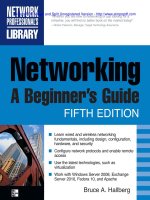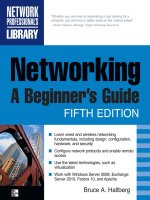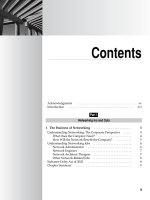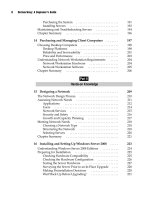Networking: A Beginner’s Guide Fifth Edition- P13 potx
Bạn đang xem bản rút gọn của tài liệu. Xem và tải ngay bản đầy đủ của tài liệu tại đây (460.33 KB, 5 trang )
42
Networking: A Beginner’s Guide
other nodes must contend with that use for their own. In other words, if you’re using a
network type with a capacity of 100 Mbps, that’s the total amount of bandwidth available
to all of the nodes connected to the hub.
NOTE Networks that are physically wired in a star topology are logically either a bus or a ring.
This means that, despite what the network looks like, it still “behaves” as either a bus or a ring.
Ethernet networks wired in a star fashion are logically a bus. Token Ring networks wired in a star
fashion are logically a ring.
Star topology networks can use one of several forms of Ethernet. The most common
is 100Base-T Ethernet, which provides 100 Mbps of bandwidth. Quite a few older
networks use 10Base-T Ethernet, which provides 10 Mbps of bandwidth. A newer
standard called Gigabit Ethernet (1000Base-T) offers 1 Gbps of bandwidth. Most
recently, a standard called 10 Gigabit Ethernet (or alternately 10GBase-X), which can
run at 10 Gbps over fiber-optic cable, has been approved.
10Base-T requires a type of twisted-pair cable called Category 3 (Cat-3) cable.
100Base-T requires Category 5 (Cat-5) cable. 10Base-T can also use Cat-5, but 100Base-T
cannot use Cat-3. These days, you should always use the most recent Cat-5 cable—
called Cat-5E—even if it’s intended for only a 10Base-T network. (Cat-5 cable provides
eight wires—four twisted pairs—and so can carry two connections in each cable if
desired.) If cost is not an issue, consider even moving up to Cat-6.
10Base-T networks share the following wiring characteristics:
N Require four actual wires (two twisted pairs in a single sheath); can be either
unshielded twisted-pair or shielded twisted-pair
N Can be run on either Cat-3 or Cat-5 cable
N Are limited to a length of 100 meters (328 feet) for each node connection
Figure 4-3. A star topology network
43
Chapter 4: Understanding Network Cabling
N Are not limited in the number of nodes in a single logical segment
N Use RJ-45 connectors for all connections (this type of connector is similar to
a modular telephone connector, but the RJ-45 is larger)
100Base-T networks are similar to 10Base-T networks and have these characteristics:
N Require four actual wires (two twisted pairs in a single sheath)
N Must use Cat-5 cable or better
N Are limited to a length of 100 meters (328 feet) for each node connection
N Are not limited in the number of nodes in a single logical segment
N Use RJ-45 connectors for all connections
1000Base-T networks are notable in that they can run over existing Cat-5 cable, but
at ten times the speed of 100Base-T networks. Running over Cat-5 cable is a significant
advantage for 1000Base-T, because over 75 percent of installed network cabling today
10Base-What?
The various Ethernet standards referred to as, for instance, 10Base-2, 10Base-T,
100Base-T, and so on contain in their name all you need to know about what they do.
The first portion—the number—can be 10, 100, or 1000, and this number indicates
the data rate (in Mbps) that the standard carries. The word Base means the network
is baseband rather than broadband. (A baseband connection carries only one signal at
a given instant; a broadband connection carries multiple signals at any time.) The
terminating letter or number indicates what sort of cable is used: T for twisted pair,
2 for thin coaxial, 5 for thick coaxial, and F or X usually indicating fiber-optic cable.
Here’s a quick reference guide to the different standards commonly seen:
10Base-2 10 Mbps, coaxial (RG-58) cable
10Base-5 10 Mbps, coaxial (RG-8) cable
10Base-T 10 Mbps, twisted-pair (two pairs, Cat-3 or
higher) cable
100Base-T 100 Mbps, twisted-pair (two pairs, Cat-5) cable; a
variant called 100 Base-T4 designates four pairs
100Base-TX 100 Mbps, twisted-pair (two pairs, Cat-5) cable
100Base-FX 100 Mbps, fiber-optic cable
1000Base-T 1 Gbps, twisted-pair (four pairs, Cat-5) cable
10GBase-X 10 Gbps, fiber-optic cable
44
Networking: A Beginner’s Guide
is Cat-5, and rewiring an entire building for a new networking standard is an extremely
expensive proposition. 1000Base-T over Cat-5 networks have these characteristics:
N Require eight actual wires (four twisted pairs in a single sheath)
N Must use Cat-5 cable or better
N Are limited to a length of 100 meters (328 feet) for each node connection
N Are not limited in the number of nodes in a single logical segment
N Use RJ-45 connectors for all connections
Compared to bus networks, star topology networks are more expensive. Much more
actual wire is required, the labor to install that wire is much greater, and an additional
cost exists for the needed hubs. To offset these costs, however, star topologies are far more
reliable than bus topologies. With a star topology, if any single network connection goes
bad (is cut or damaged in some way), only that one connection is affected. While it is true
that hubs echo all the network signals for the connected nodes to all other nodes on the
hub, they also have the capability to partition, or cut off, any misbehaving node connections
automatically—one bad apple won’t spoil the whole bunch. In addition, because each cable
is run directly from the hub to the node, it is extremely easy to troubleshoot; you don’t need
to go traipsing over an entire building trying to find the problem.
Ring Topology
A ring topology is actually not a physical arrangement of a network cable, as you
might guess. Instead, rings are a logical arrangement; the actual cables are wired in a
star, with each node connected on its own cable to the MAU. However, electrically, the
network behaves like a ring, where the network signals travel around the ring to each
node in turn. Figure 4-4 shows a sample ring topology network.
Ring topology LANs are based on Token Ring instead of Ethernet. Some may also
run Fiber Distributed Data Interface (FDDI)—a 100 Mbps fiber-optic network—instead
of copper-based cable. Rings are also used for some larger telecommunications
networks like Synchronous Optical Network (SONET), as well as in storage area
networks and some other applications.
DEFINE-IT! Physical Versus Logical
You’ll often hear the terms physical and logical bandied about when discussing
networks. These terms are used for quite a few different things. Physical, used in
the context of networking, means the actual, physical thing—what you can see and
feel. Logical means how something works, despite its appearance. For example, a
Token Ring network is physically wired in a star; each cable radiates out from the
MAU to each node. Logically, though, it’s a ring in which the signals travel from
node to node in a circular fashion. The fact that the signals physically travel from
the node to the MAU and back to the next node is usually unimportant when
thinking about the logical circular arrangement of the Token Ring network.
45
Chapter 4: Understanding Network Cabling
Figure 4-4. A sample ring topology network
MAU
Flow of
tokens
Ring topology, electrical representation
Ring topology, physical representation
46
Networking: A Beginner’s Guide
Comparing Rings to Stars and Buses
To compare rings to stars and buses, you first need to understand the basic concept of
how Ethernet networks work. Ethernet networks manage all the needed signals on the
network using a technique called CSMA/CD, which stands for Carrier Sense Multiple
Access with Collision Detection. CSMA/CD allows each node on a segment to transmit
data whenever it likes. If two nodes try to transmit at the same time, they each detect
this occurrence with their collision detection, and then both nodes wait a random
amount of time (counted in milliseconds) to retry their transmissions.
Considering how data packets flow on a network using CSMA/CD, you might
think that it could quickly become a confusing mess, with data and collision retries
causing more collisions. And you would probably think the potential exists for the
network to reach a saturation point where virtually nothing gets transmitted because
of excessive collisions. You would be right. For 10Base-T networks, this point occurs
somewhere around 3.5 Mbps (about one-third of the 10 Mbps theoretical maximum
that one node could achieve sending a stream of data to one other node). However,
the reality is that excessive collisions don’t pose much of a problem on most networks
these days for three reasons:
N Most network traffic is bursty, and network nodes rarely consume all the
bandwidth on a particular network for any significant length of time.
N Even on a network where excessive collisions are hampering performance,
breaking the network segment into smaller pieces and reducing the chances of
collisions proportionately is relatively easy.
N Currently, most networks use switches instead of hubs. Switches prevent data
from colliding between their ports.
Ultimately, CSMA/CD does the job, and Ethernet is the predominant network
standard in the world because it works so well in practice and is so flexible.
Token Ring networks operate on a different principle than CSMA/CD. Token Ring
networks manage their bandwidth with a technique called token passing. Electrically, a
data entity called a token circulates around the logical network ring. The token has two
states: free and busy. When a node wants to transmit some data, it waits until the token
coming into it is in a free state, and then the node marks the token as busy. Next, after
adding to the token packet the data to be sent and the destination address, the node
sends the packet on to the next node. The next node, finding the token set to its busy
state, examines the destination address and passes the token on unchanged toward
the destination. Once the destination node receives the token, it gets its data, marks
the token as free, and sends it along to the next workstation. If the token somehow
becomes “lost,” then a workstation generates a new, free token automatically after a set
period of time passes.
The beauty of Token Ring networks is that they behave predictably as the
bandwidth needs of the nodes increase. Also, Token Ring networks are never bogged
down by collisions, which are impossible in such a network. However, these benefits









